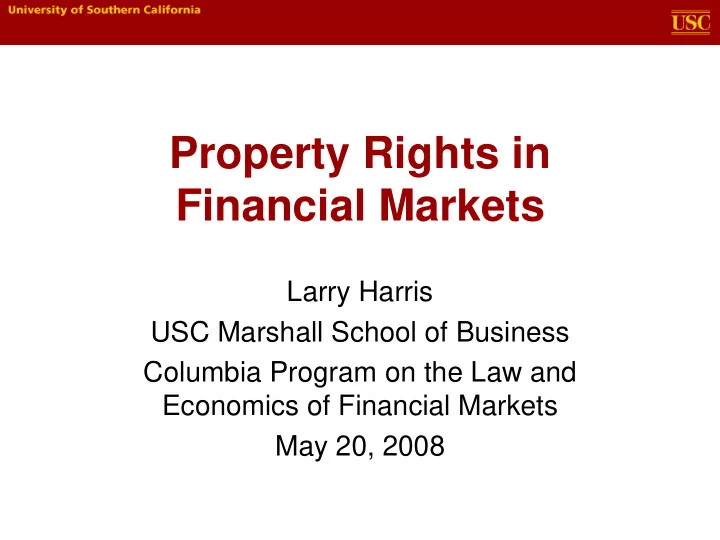

Property Rights in Financial Markets Larry Harris USC Marshall School of Business Columbia Program on the Law and Economics of Financial Markets May 20, 2008
Introduction • The identification of important issues is a key object of the Program on the Law and Economics of Capital Markets. • I will provide a quick survey of property right issues in the financial markets. • These issues all have substantial public policy implications. 2
Properties in Financial Markets • Most properties contested in financial markets are intellectual properties. • Network externalities free rider problems substantially complicate ownership issues for many financial products. 3
Common Economic Issues • Our main focus today – Network externalities • Other common economic issues associated with intellectual property – Free rider problems – Incentives to innovate and copy – Monopoly costs 4
Today’s Topic Agenda • Big network externality problems – Ownership of futures contracts – Market data • Other topics – Publication of fund portfolio positions – Security research and ratings – Innovative financial products and processes 5
Futures Contracts
Contract Monopolies • Enforced by exchange clearinghouses • Backed by federal laws preventing off- board trading • The order flow externality provides extraordinary protection to incumbents. • Contrast to the Options Clearing Corp • CME-CBOT and CME-NYMEX mergers • Competition from OTC derivatives 7
Intellectual Property Issues • Contract design can be expensive but monopoly can be too. • Contrast to patent law – 20 years of protection, not forever 8
Patents • Provide incentive to invest. • Create incentives to share inventions to promote further inventions. – Not necessary when keeping trade secrets is difficult • One-size-fits-all and litigation problems 9
A Related Design Issue • Who should own the right to write contracts on well-known indices? – S&P, Dow, Russell, MSCI, … – Presently the index manager • Should index managers be able to extract the benefits of the network externality? • Did you see Titanic ? 10
Market Data
Exchanges Sell Market Data • The order flow externality makes the data from the largest exchanges valuable. • The data facilitate crossing, internalization, and preferencing. • Exchanges and traders both argue that they should own the data because they produce them. • Securities and futures market differences 12
The Reg NMS Solution • The order flow externality arises because an offer to trade is an option. • Price the externality! 13
Position Reports
Mutual Funds • Mutual funds must publish their full schedule of portfolio positions within 60 days of the end of each quarter. – Forms N-Q and N-CSR • Allows interested investors to monitor whether a fund is complying with its stated investment objective • Reveals proprietary fund strategy and front-running opportunities 15
Other Position Reporting Regs • Institutional investment advisors must report aggregate positions within 45 days of the end of each quarter (Form 13F) • Actively managed ETFs must report daily – In effect, giving up all proprietary research in favor of a market-based distribution system – Other actively managed ETF proposals have been stalled at the SEC for at least five years. 16
Research
The Research Problem • Information is easily shared, making it hard to control its distribution. • People pay for a first look but not everyone can get a first look. • Issuers pay if the consumers will not. – Research can lower cost of capital. – All sorts of related agency problems 18
An Additional Twist • By writing regulations that depend on private credit ratings, the SEC – Uses rating agency properties – Creates markets for the ratings • Since the SEC does not own the ratings, it has limited control over them. 19
Innovative Financial Products
Patents versus Trade Secrets • Trade secrets are hard to control with a mobile labor force and little physical capital. • Poorly issued patents lead to extortion. • Without patents, the regulatory approval process allows slow competitors to catch up to innovators. – Examples: Index participations, ETFs, … 21
Conclusion
Property Rights Are Difficult • Many disparate governors – Patent law – Superseding agency jurisdictions – Network externalities and free rider problems • Many disparate and conflicting interests – Among private rent-seekers – Among public policy values 23
Some Proposed Principles • Results should not depend on network externalities and free rider problems. • Externalities should be priced, if possible. • Regulators should not undercut incentives to innovate • A balance between the benefits of innovation and the costs of market power should govern market structure 24
Free and Competitive • We seek free and competitive markets. • Too often people associate the former with the latter. • Externalities and free rider problems often make free markets uncompetitive. – Free marketers often ignore these problems. – Simple is not necessarily good. • Benefits and dangers of regulation 25
Recommend
More recommend